

The Reality of Media Censorship in Malaysia
The Malaysian government currently practices some of the strictest
controls on publishing, the media and freedom of expression of any country
in the world, according to
Amnesty International.
Of course, all nations are guilty of some human rights violations, and no
country is perfect. Amnesty International even criticizes, for example, the
U.S. over many of its political practices. Also, the Malaysian people are a
civil, kind and hospitable populace.
However, for the reasons stated above, getting to the actual truth of
any kind of Malaysian "urban legend" is virtually impossible. An objective
public record of a great many Malaysian news events often simply does not
exist.
The Real French Connection
Although many persons nowadays don't know it, much of Southeast
Asia was once as French as Paris or Martinique.
From 1864 onwards and starting with Saigon, Vietnam (now Ho Chi Minh
City), the French moved aggressively to conquer and control most of
Indochina, including the modern Laos and Cambodia in addition to
Vietnam.
This control lasted until the Japanese drove them out in 1942. When
World War II ended, the French tried to reassert themselves but were
defeated by the locals decisively in 1954.
However, the influence of French language and culture remains in these
areas. Many people there still speak French, enjoy eating snails and even drive on the
"right" side of the highway!
C'est la vie!
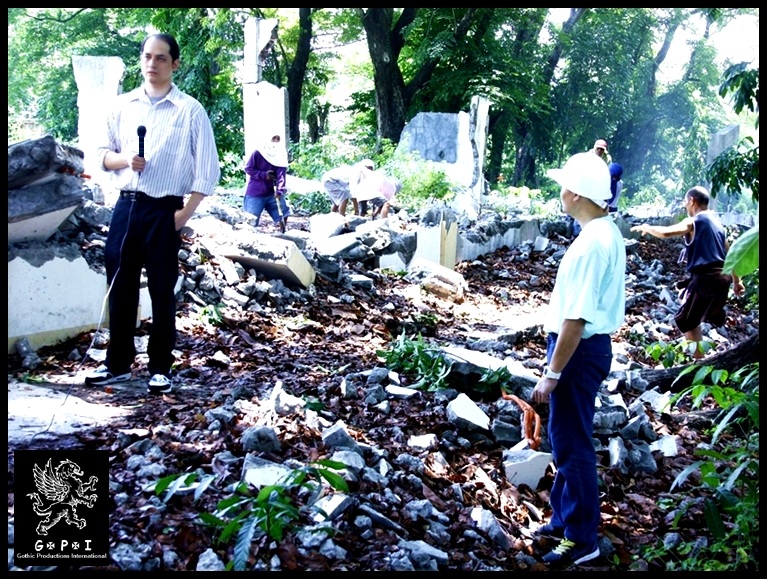 According
to the few stories told in private or huddled in secret, it all began on
Chinese New Year in February 2003. The events in question occurred at an
isolated place in the Cameron Highlands of Malaysia.
A Chinese family held a festive New
Year gathering on February 1. This celebration was supposed to be a
happy occasion. Instead, it ended in tragedy.
According
to the few stories told in private or huddled in secret, it all began on
Chinese New Year in February 2003. The events in question occurred at an
isolated place in the Cameron Highlands of Malaysia.
A Chinese family held a festive New
Year gathering on February 1. This celebration was supposed to be a
happy occasion. Instead, it ended in tragedy.
On the following day, local folks found only the ruins of a wealthy
family's mansion. To this day, no one knows what happened to them. No
bodies were ever found, or so the story goes.
Was it a crime? Or were supernatural events to blame? No one can tell or
even wants to find out. The local government says it didn't happen at
all.
Some say persons with powerful influence covered up news of the event. Family
members and others were hushed. One reporter from Penang, who tried to
find out more, received threats to his career and even his life.
A Chinese family of about 20 people simply vanished, according to some
reports. Nobody ever found out what happened to them.
Clearly, if this event did occur, it was more than just an ordinary
crime. However, the facts never came out. The truth was not heard.
Justice was never done.
The photo above is from a dramatization of horrific events alleged to have happened to the missing family, as dramatized in the Philippines for Darkest Night. For an explanation of why this film had to be shot in the Philippines with Filipino and other "stand-ins" for the persons in the original Malaysian story, click here.
Our own videotape here of a film-maker who lived in Penang for many years, who wishes to remain anonymous. The videos below show him telling us part of an amazing story. On this Web page we call the primary reporter on the scene "Johan." Although "Johan" refused to appear on camera, we were able to talk with him briefly by phone to confirm the story told in this interview. What follows here is a fascinating interview, in two parts, with a close friend and former co-worker of Johan's, who wanted us just to call him "Thomas." He came forward to tell his story of his own free will. Here is what he told the writer and producers of Darkest Night:
The man, whom we call "Thomas," told us the incredible story that later formed the basis of the film Darkest Night. We cannot honestly say we know it's a true story, because we could not independently verify the information given us by this man, except for the brief conversation with "Johan" discussed earlier. Much of this account is second hand, from "Johan." In fact public sources, who wouldn't allow us to reveal their names, told us this story is a lie. On the other hand, many more private persons, including some family members of those who disappeared, say the stories are credible. Still, even they couldn't say for sure whether his whole story is the truth. No one connected with the film ever actually saw the videotape. However, the screenwriter recorded what "Thomas" said as faithfully as possible and included the main points of his account in the script.
After learning about these events from "Thomas," the writer and producers of this film did a lot of digging into the history behind the accounts given by these two men. To our astonishment, we discovered that the story didn't begin in 2003 or even a few years or decades ago. To understand the truth, anyone really interested has to search as far back as 130 years ago—and as far off as Paris, France, to learn of another family with a much darker and different agenda.
Two weeks after the interview shown above, "Thomas" received a small book in the mail, with no return address. He immediately gave it to us. This was the last time we ever saw him. The book turned out to be an amazing document purported to be a diary found in the ruins. It appears that it was written by young Chinese woman (in the original story), who was engaged to be married. Her Darkest Night stand-in was named Susan Reyes, played by Anne Gauthier. The document is in Mandarin Chinese, and we will reveal more about its contents here at a later date, once it is translated and authenticated.
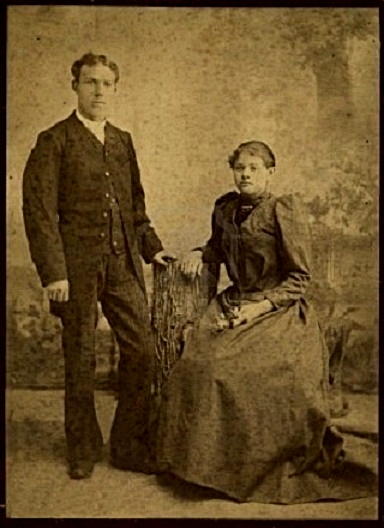 Corinne
Boulanger was an impressionable and sensitive young girl from a
reasonably wealthy Parisian family. She grew up a devout Roman Catholic
and attended Mass faithfully every Sunday from her earliest days. By age
18 on April 4, 1881, her life had all the earmarks of the contemporary haute
bourgeoisie of her time
and place, ready to "marry up" to even more wealth.
Corinne
Boulanger was an impressionable and sensitive young girl from a
reasonably wealthy Parisian family. She grew up a devout Roman Catholic
and attended Mass faithfully every Sunday from her earliest days. By age
18 on April 4, 1881, her life had all the earmarks of the contemporary haute
bourgeoisie of her time
and place, ready to "marry up" to even more wealth.
On the evening of her 18th birthday, she became troubled and nervous.
Her parents, Catherine and Etienne, said she was just tired from a day
of celebrating and sent her to bed early. That night, she had a series
of fitful and profound dreams. At times when she awoke, she saw visions.
After Corinne got up the next morning, she reported having strange
dreams and even seeing spiritual visions. As soon as she could, she
began to write in a journal, setting down all the things she saw and
experienced during her "revelations." The following night was similar
for her, except so intense she went into seizures, and her frightened
parents called their doctor.
Once again, Corinne wrote down all the dreams and visions she
experienced. Her ordeal went on for a week, exhausting the entire
family. Afterward, Corinne announced to all of them that her "god" had
given her a series of visions and told her to start a new religion. The
name he gave himself as he spoke to her in his own voice was "Baphomet."
After she showed her parents her own drawing of this new "god," they
were horrified and immediately called their Catholic priest. Shocked,
the minister saw her sketch of a horned goat-man being. Certain that
this was Satan, he took Corinne to confession and absolved her of this
"sin." Still, she steadfastly refused to renounce her revelation as
demonic.
Her parents took her to more doctors, and forced her into bizarre
"treatments."
Long arguments with her family ensued. Finally, their priest even
threatened to have Corinne excommunicated from the church.
Finally, Corinne realized that she shouldn't press her ideas further and cunningly put the incidents behind her. She told no one else and led her family to believe that she was "recovered." Corinne didn't speak of her "religion" or revelations again for over a year. Secretly, she did continue keeping the journal and added to it often, as new ideas and impressions came to her.
The photo on the right above Is the only known surviving picture of the Devereauxs, taken shortly after their marriage in April 1882.
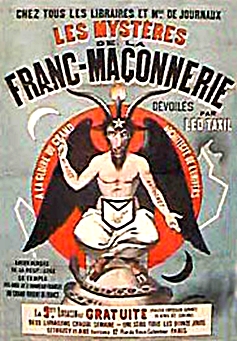 Almost exactly a year later, Corinne met André Devereaux, 27,
at a friend's party. They immediately fell in love and eloped to
get married soon afterward. Her family of course, opposed the
marriage vehemently and rejected both of them.
Almost exactly a year later, Corinne met André Devereaux, 27,
at a friend's party. They immediately fell in love and eloped to
get married soon afterward. Her family of course, opposed the
marriage vehemently and rejected both of them.
The news soon came out that André was a defrocked Catholic priest. He had been kicked out of the priesthood two years earlier for having sex with underage girls and not being discreet about it. This information scandalized Corinne's family, friends and neighborhood. The couple had no choice but to leave the area. They moved into the Parisian Latin Quarter and lived a "Bohemian" lifestyle typical of folks in those days who defied prevailing social and religious norms.
Not too long after their move, the Devereauxs saw a poster similar to
the one shown on the right, advertising a local contemporary Baphomet Cult meeting. Eliphas
Lévi, the cult's founder, had died seven years earlier, but the
movement continued. Corinne had shared her visions and beliefs in the
occult with her husband and excited his interest as well. They quickly
resolved to attend.
After going to a few meetings, the Devereauxs became involved in the
congregation for several months. However, after Corinne showed the
group's leader her writings and insisted that they all follow them, the
man was shocked. The congregation quickly kicked the couple out and
disavowed their version of "Baphomet religion."
Undeterred, the Devereauxs took a few of the members with them and began
a home "study group" in their small apartment in the Quarter. They
started their own congregation and were even able to rent a tiny
store-front meeting place by early 1884. During the next few months,
their following grew to more than 300 members, and they moved to a
larger "temple."
However, by August 1884 dark rumors were rife in the neighborhood.
People whispered about their "strange sexual practices" and even "human
sacrifices." In that same month, a young girl disappeared from the area,
and many blamed this "devil cult." Soon, there was talk among
many in the area, of a plot for
revenge.
On September 4, 1884 a mob of locals stormed into an evening meeting led
by the Devereauxs, at their temple. Violence ensued, and the couple plus
a few of their closest friends barely escaped with their lives. Several
congregants disappeared, and a police investigation followed soon
afterward.
Later, news got out that the missing congregants were literally lynched by the angry crowd, but the police ignored them. Instead, they focused their anger on the Devereauxs and their temple leaders who had fled and couldn't be found. Two weeks later, Parisian courts issued warrants for eight persons, including the Devereauxs, for multiple murders and "crimes against nature." However, none of the suspects were ever found. Corrine, André and the other six had apparently fled the country to avoid prosecution.
The preceding facts are all that are available in local public records and existing personal accounts, which historians of the occult have been able to find in Paris. However, these same historians did piece together further accounts of the Devereauxs and their "Baphomet Cult" through second-hand accounts, fragmentary records and local rumors from different parts of the world.
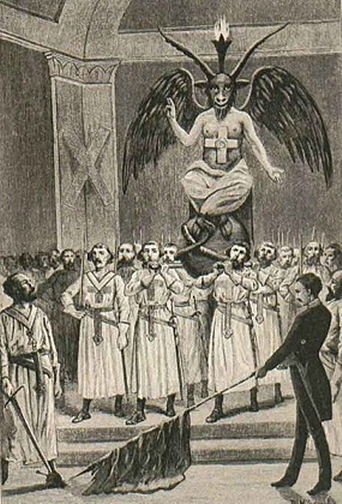 Some
credible contemporary evidence shows that, by January 1885, a Baphomet
temple existed and was thriving on the island of Martinique, in the
French Caribbean. In the town of Fort-de-France, a couple who called
themselves "Alpha" and "Omega" ran the congregation with great success,
some said, by incorporating local voodoo practices into their rituals.
Some
credible contemporary evidence shows that, by January 1885, a Baphomet
temple existed and was thriving on the island of Martinique, in the
French Caribbean. In the town of Fort-de-France, a couple who called
themselves "Alpha" and "Omega" ran the congregation with great success,
some said, by incorporating local voodoo practices into their rituals.
By July of that year, reports began to surface of a book, written by
Corinne, which brought together and specified all of their rites,
history and practices. Its title was Le Chemin
de Baphomet (The Way
of Baphomet) and contained three parts: a grimoire (book of magic
spells), a history of the cult and finally orders of formal services,
which differed little from common rites of the Roman Catholic Church,
except for the use of pagan statues (see the drawing on the right).
As before, dark rumors of sexual debauchery and human sacrifice spread
about the local community. Black magic also became a part of the
"legend." By the end of the year, the group was widely feared but also
respected. "Alpha" and "Omega" were declared a priest and priestess by
local voodoo practitioners. In addition, voodoo high priests in
Fort-de-France declared that "Omega," the female of
the pair, was a saint.
Opinions on the island split about the cult, because they did both good
and evil. Reportedly, they were able to heal and bring prosperity, but
these blessings were possible only at the price of human blood and
sacrifice. Persons who openly opposed the cult reportedly ended up with
bizarre deformities. However,
these were only rumors, and no one had any hard evidence of wrongdoing.
By early 1886, the cult had become so famous (or infamous) on the island
that local authorities began to take notice. The rumors of human
sacrifice and other crimes could no longer be ignored. The French police
chief in Fort-de-France realized that "Alpha" and "Omega" bore a
striking resemblance to photos on the Devereaux couple on "wanted"
posters from Paris.
It took the local police only three days to come up with arrest warrants for the couple and many of their followers. On February 24, 1887, officers broke into their temple building only to find it deserted. There was no violence this time, but it was as if the cult had known every move of the police in advance. Again, the Devereauxs and their devotees pulled off a disappearing act. Afterward, an extensive search of the island yielded nothing. The police chief was left looking like a total ass.
Legends of the Devereauxs and their "religion" abounded among lovers of the occult during the late 1880s. However, the most credible stories place their next settlement near Saigon (now called Ho Chi Minh City) , in Vietnam, part of French Indochina in southeast Asia. Apparently the group had made the long, perilous trip by boat around the tip of South America (there was no Panama Canal in those days) and ended up in Asia.
By November 1888, reports of a mysterious couple who called themselves simply the Priest and Priestess sprang up all about the area. By now, the Devereauxs were almost legendary, and many French and Asian occultists suspected the infamous Baphomet Cult had resurfaced. Once more, a couple built a temple and garnered a huge following. Again, there were the same rumors of sex, magic, and murder. However, by March 1889, the local authorities had had enough. This time, instead of trusting the police, the French governor in Saigon mobilized his colonial army unit.
On April 15, 1889, soldiers marched on the temple building without warning, fired artillery and destroyed it completely. No one bothered to ask for a warrant this time. However, no bodies were ever found. Witnesses said the destruction was so total on one even bothered to search for remains. The entire area was immediately buried by workers, flooded and turned into a rice paddy. In Paris, the Devereaux case was closed, and the authorities there congratulated themselves that they would never again be troubled by this bizarre and bloody cult.
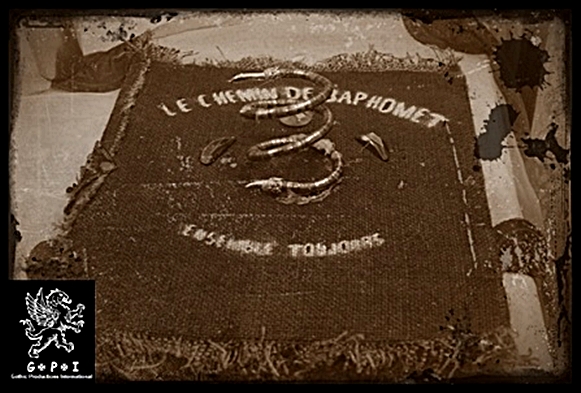 However,
many say the story didn't end in Vietnam. Although the French never
worried with the Devereauxs again, ample evidence points to their
resurgence for one last time and in a different empire. In 1890, what is
now Peninsular Malaysia was under British control and called British Malaya. Occult
historians believe that the Devereauxs and their cult learned their
lesson and abandoned the French empire. It would have been a short move
from Vietnam to the Malay Peninsula, and many believe the same cult had
once again evaded authorities.
However,
many say the story didn't end in Vietnam. Although the French never
worried with the Devereauxs again, ample evidence points to their
resurgence for one last time and in a different empire. In 1890, what is
now Peninsular Malaysia was under British control and called British Malaya. Occult
historians believe that the Devereauxs and their cult learned their
lesson and abandoned the French empire. It would have been a short move
from Vietnam to the Malay Peninsula, and many believe the same cult had
once again evaded authorities.
Reports began to surface as early as January 1890 that a strange,
foreign group had bought a large tract of land near Kampung Tingkap,
Malaya. They built a walled, secretive compound there in a mountainous
region known as the Cameron Highlands.
No one knew much about them except that they spoke French, built their
own village and had their own religion. These outsiders consistently kept
to themselves. When they recruited, it was always from foreign shores,
and no one knew where newcomers to the cult came from.
Even now, little is known about this group, but authorities on the occult are virtually certain that the Devereauxs and their Baphomet Cult had relocated there. Having learned their lessons from the past, they kept all of their lives and practices totally secret from the locals. There was no longer any French government to contend with. They "evangelized" from far-away places so as not to disturb the nearby Muslim population. When they ventured outside their compound, they did so in groups and talked to their neighbors as little as possible. There were even some reports that group members were seen carrying a strange book that they revered like the Bible. A few even reported that the title was definitely Le Chemin de Baphomet (see the photo recreation above from Darkest Night).
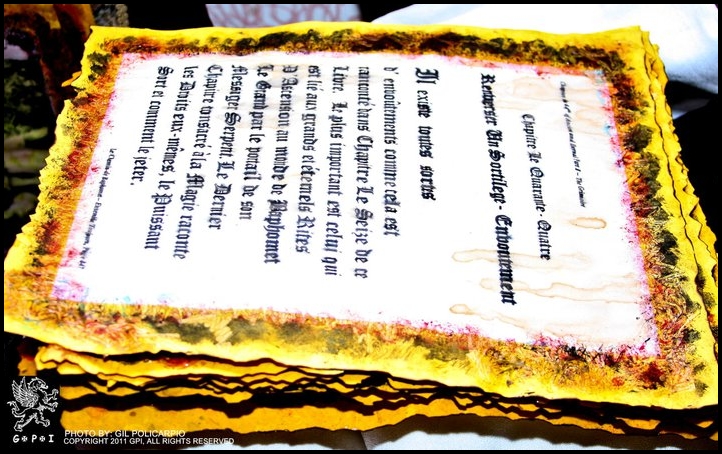
Believers in the occult, who have studied the Devereaux phenomenon, contend that not only were they smarter during their stay in Malaya but more powerful too. Now left to their own devices, they were free to seek the will of their "god" Baphomet and follow their own goals and purposes. Many even say that their magic was so strong by now that they were beyond the touch of any earthly authority.
This situation continued for 24 years and then abruptly ended. On the morning of February 2, 1914, a group of locals walked toward the compound and realized it was gone. The walls had vanished. On closer inspection, they saw that the walls and village were in ruins. Several days of searching turned up no bodies. An estimated 200 or so persons had simply disappeared. No trace of them was ever found. Even though there are many theories, to this day, no one knows exactly what happened. This event remains one of the great unsolved mysteries of the modern occult.
NOTE: In 2003, the Chinese New Year happened to fall on February 1, which is also the ancient pagan holiday of Imbolc. This "special time" for the ancients often included feasts, orgies, sacrifices, horned gods and serpents. Many ritual "marriages" were done at this time, accompanied by violence. This day has been traditionally associated with Baphomet. In Darkest Night, the family holiday was changed to Christmas (also a day originally associated paganism due to the winter solstice) because most Filipino families do not celebrate the Chinese New Year.
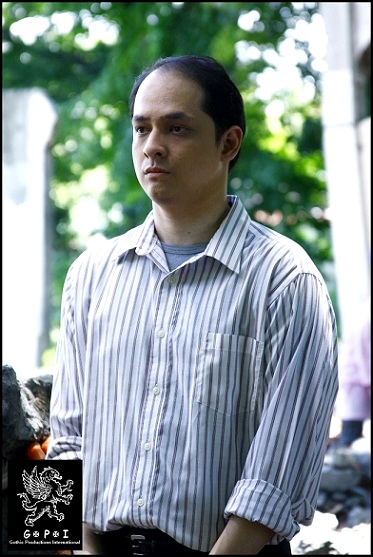 Now
enters a reporter from Penang, Malaysia whom we will call "Johan." The
time is February 2, 2003. The television station he works for has asked
him to investigate an unusual crime. So, he gets into his van with a
cameraman and drives to the Cameron Highlands mountains near Kampung
Tingkap.
Now
enters a reporter from Penang, Malaysia whom we will call "Johan." The
time is February 2, 2003. The television station he works for has asked
him to investigate an unusual crime. So, he gets into his van with a
cameraman and drives to the Cameron Highlands mountains near Kampung
Tingkap.
He's not really thrilled about investigating the story. Even though he's
Malay, he was out celebrating the Chinese New Year the night before,
partying with some friends. Today he has a terrible hangover and wishes
he was home. Every time he gets a hangover, he also wishes he was a
"good" Muslim like his brothers and never drank alcohol.
After a long trip, he arrives at the alleged "scene of the crime." The
story he hears from the locals is amazing. A family had lived in this
house for the past five years. Overnight, the house crumbled to ruins
and everyone there disappeared. They could find no bodies.
At first, Johan is skeptical. But as he talks to all the witnesses, a
nagging feeling gets to him. He's been a reporter for 12 years, and he
knows when someone is telling the truth. These people are sincere.
He returns to Penang ready to put together a great story. His boss
greets him on his arrival and tells him to forget about the whole thing.
There will be no television report. He takes the tape from the camera
and dismisses Johan and his co-workers.
Dejected, Johan goes to his desk. He still has his notes. He puts them
in a safe place, now determined to find out more about what he just saw.
Soon the word is out around the office: Everyone should just forget
about what happened in the Cameron Highlands. Johan realizes that, if he
wants to stay on this story, he will have to keep his efforts a secret and do it on
his own time.
During the next few years, a fascinating story unfolds as Johan quietly
does his homework.
The photo above shows Jonas Gruet who plays Danny Valencia, the stand-in for "Johan" in Darkest Night.
In 1997, a wealthy young Chinese couple with two children bought the tract of land that Johan had visited. Shortly afterward, they built a mansion there. Reportedly, the wife said she had felt "strangely drawn" to this place. They wanted this home to be their "dream house," and conveniently erected it on the foundations of an older building that had been at that same place decades ago. The family had an interesting history.
The man's father was a Chinese American who had married a Chinese woman from Malacca. He was in the American military at the time and met her in Singapore while on leave. They moved to San Francisco and had four children. The eldest son became a big success in the computer industry. There were also two boys and a girl, now adults as well.
After the father retired, his homesick wife convinced him to move to Malacca, where she could be closer to her family. Their children visited them often and ended up marrying Malaysian women, except for one, who was sort of the "black sheep" of the family and moved around a lot, remaining unemployed and living off his parents.
The eldest son married a half-Chinese and half-Vietnamese woman from Penang. She had two younger sisters whom she reared from an early age after their parents tragically died in a fire. Also, she took after her mother and had extremely French tastes and manners, even down to speaking French fluently. Shortly after getting married, they decided to build their first house together and located it in the Cameron Highlands. They chose a somewhat isolated area because they wanted privacy and the chance to "get away from it all."
Their neighbors said that after their first year in the house, people noticed that the wife began to change. She became sullen, quiet and withdrawn, often unfriendly. Still, she was a good mother and wife to her husband, and folks just accepted her quirks and strange moods. Then, for a year before the disappearance, they hardly saw her at all. She became a hermit at the house, rarely driving around or even going to town.
Meanwhile, her sisters lived in Kuala Lumpur but visited often. They had been virtually adopted into the family. The older of the two was a university student. In early 2002, she met a young American man and fell in love. They became engaged and, as young lovers do, spent much time together. Finally, they resolved to announce their engagement to her family.
In late 2002, the eldest sister sent out invitations to a Chinese New Year family reunion at their mansion in the Cameron Highlands, to happen on February 1, 2003. Almost all of their family would be there. She and her fiancé decided to announce their engagement at this celebration. The couple and the woman's younger sister, as well as almost everyone else in the family gathered there on that fateful day.
|
On the right, DJ Perry and Anne Gauthier play Ken Tyler and Susan Reyes, stand-Ins for the young, American and Chinese engaged couple in the original story. |
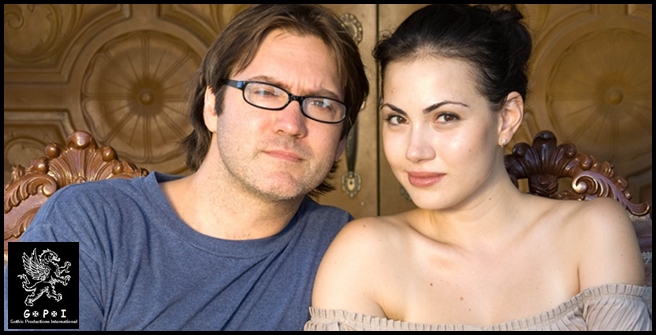 |
The next day they had all vanished, and the mansion was destroyed. There were quiet rumors that the "crime" was really a demonic visitation of some kind. Even the name of the hill where they built their mansion sounded ominous, "The Hill of Demons." Yet, no family member there ever reported any of the typical paranormal symptoms of a haunting at the house. No one saw apparitions, had visions or heard voices, experienced poltergeists or photographed strange things. The house had been quiet and happy for five years.
In fact, local family members seemed afraid to talk about the event at all. To get any information from relatives, Johan had to travel to Malacca in October 2004, where some of the victims' blood relations were eager to talk. One of these persons mentioned an interesting connection. The name of the place, "The Hill of Demons," originated around 1900 because some kind of "devil cult" had existed there. This new information sent Johan in a totally different direction. He spent the following two years researching the Devereaux family and their amazing odyssey from France to Asia.
By late 2009, Johan had put together a detailed and puzzling story of an ordinary, although wealthy family that fell prey to an unusual, terrible crime, possibly occult-related. Was it a family member gone mad? Did a group from elsewhere in Malaysia or a foreign country plot an elaborate robbery and destroy the evidence? Could it have been a serial killer? He never found answers to these questions. Then, there was the whole history of the Devereaux cult. Could that have been involved in some way? Was there some kind of supernatural or demonic connection?
In addition, Johan had a troubling question that had haunted him from the start. Why did his boss, almost seven years ago, tell him to bury the story? No word of this crime ever reached the Malaysian or any other media.
 |
From left: Czarina Llane Kwong, Issa Litton, Allen Dale Alojipan, and Clark Gamul play the Espino Family in Darkest Night; they are the stand-ins for the missing Chinese Malaysian residents of the destroyed mansion. |
One of the most interesting twists to the tale is that the young Chinese woman's boyfriend (called "Ken Tyler" in the film) and fiancé supposedly disappeared along with the rest of her family. Did his family make any inquiries? In fact, they did but never found any credible evidence of his whereabouts.
Rumors persist that the young man's parents and other members of his family flew to Malaysia from California in the summer of 2003 to seek out the truth. The family only stayed in the country for about two weeks and then promptly returned home. They never pursued any leads, asked for help from the U.S. embassy or talked to the media. Stories persist that something or someone in Malaysia scared them so badly that they have steadfastly maintained silence to this day.
The producers of this film happen to know that this situation has not been easy for the missing American's family. However, they refuse to allow their names to be used or their exact location revealed. Also, they won't give any reason why they keep as quiet as they do. They were interviewed briefly, but only off the record, at their request.
So why do they refuse to talk? All they will say is to ask local government officials that same question. According to the best sources, these same officials deny that this whole story ever happened and that it's all just a rumor, fiction or "urban legend." Malaysian bureaucrats say that this U.S. family doesn't exist. Of course, we have talked to this "nonexistent" family. What we don't know for certain is why they keep their grief-stricken silence, even after additional evidence surfaced.
What evidence is this? On April 4, 2010, Johan got his first big break in the story in seven years. People were buying the lot in the Cameron Highlands where the family had lived and planned to clear away the ruins and build another house. Early in 2010, he developed the idea of making a film documentary on the "crime" and exposing a possible cover-up. If he couldn't get the film to show in Malaysia, he hoped to release it elsewhere. This uncovering of the house's remains would make fascinating video footage for his account.
On his own time and at his expense, he gathered a cameraman, sound man and an assistant, took a day off work and headed to the Cameron Highlands once again. Hard evidence of the crime or whatever happened could surface as the site was excavated. After they arrived, Johan got his crew set up and started the routine filming of the area and ruins with interviews of the workmen present.
About an hour after his arrival, the workmen found something that changed Johan's life forever. Buried deep beneath the rubble was a heavy plastic bag containing videotape. It was labeled in a strange Mandarin handwriting "Christmas Day 2003." They also found a box filled with additional records and other objects that were possibly artifacts of black magic and an occult religion. Bribing the workers and swearing them to silence, Johan took his incredible findings back to Penang for further study. Most of all, he wanted to view that videotape, if it was still watchable.
The video was of better quality than he could ever dream of. The entire story came together for him that night, all of the things he had researched for the past seven years. Johan would never say exactly what the video showed, but he described a family cut off from the world that night and beset by demons of black magic and the occult. These same demons did unspeakable things to everyone present and destroyed the house. Johan took a week's vacation from work after viewing the videotape. He was shaken utterly and had nightmares for days afterward. At times, he feared for his sanity.
From that day forward, Johan became a "good Muslim" once again. He swore off alcohol, began going to Mosque services regularly and reconciled with his family. However, he refused to forget about his story. If anything, the possession of this videotape and the other artifacts infused him with more passion to tell the story of this family and their terrible end.
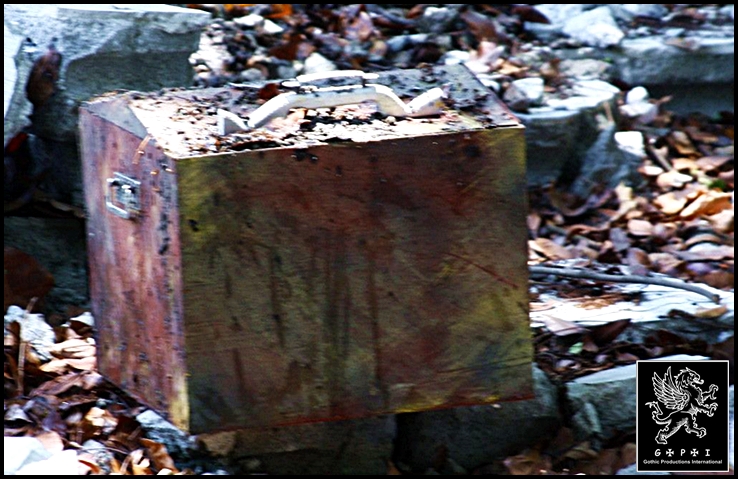
Johan never knew how others found out about his discovery. Maybe some of the workmen from the construction site talked to officials. Perhaps his friends weren't as loyal as he thought. It could have been the Internet. Sometimes, he even believed his condo was bugged. In the end, it didn't matter though, who or what told of his find. The word got out. Two weeks after he viewed the videotape, the phone calls started.
No one on the phone during these calls ever gave a name. Johan received so many during the next five weeks that he lost cost. They came at all hours of the day and night. Some were just silent. Most told him forcibly to keep quiet about the story and destroy the evidence. Many even threatened his life, job and career. Others also hinted at harming his family. By mid 2010, he was terrified and hid all the evidence in a safe place. To this day, no one knows where, except for Johan. By then he knew his documentary would never be made.
Why did Johan's manager quash the story back in 2003? Why did Johan receive the phone calls? Was it fear for the real estate values or tourist travel in the Cameron Highlands? Did members of the government have darker motives? Was there some kind of cover-up conspiracy? Johan doesn't know and refuses to try to find out. Now, he just lives quietly and hopes nothing ever again connects him personally with this story.
There's an old saying that "The truth will out." An important difference divides the Malaysia of 2003 and 2010: Greater coverage by the Internet. The producers of Darkest Night have been able to solve at least one of the mysteries surrounding this case. Apparently, a few persons present at Johan's discovery posted some fragmentary information about the story on the Web. Interestingly, such items almost immediately disappeared from online, but not before a few rumors got out. However, these tales were very few and mostly discounted by those who heard them.
Obviously such rumors probably got to the wrong persons and turned Johan's life into a living hell. However, one source of rumors was willing to tell the story that formed the basis of the screenplay for Darkest Night. As the film's producers tried to make the film, they finally decided it was best to do so outside of Malaysia. Why was this? The complete tale of how this story traveled from the Cameron Highlands of Malaysia to the Philippines appears on this website. To read about this long and interesting journey, click here.
As stated earlier on this page, many of the incidents and events, as well as all of the names in the story, had to be fictionalized. What we heard was the account Thomas told from Johan's telling of what was on the tape. So, we only received an outline, roughly sketching the events of that night in 2003. Here's a summary list of what the writer had to fictionalize or create to make a cinematic and complete storyline for the film:
We have video recordings of our one source willing to talk on camera as he tells us what he knows. This interview appears near the beginning of this page (click here). The writer and producers of Darkest Night were able to discover this eyewitness, who was working with Johan in Penang when the videotape was discovered. He claims he was actually with Johan and his crew the day the videotape and other things were discovered. No one else we met in connection with this story wanted to talk, except for this one man. Our on-camera source is the Chinese assistant helping out with the documentary before it was shelved. He was only willing to appear on camera, as disclosed earlier, anonymously, and he wanted us to call him "Thomas" and hide his identity. In the videos on this page, he tells his story.
In additional interviews, he gave the complete account of the things Johan told him, including what appears on the found videotape. However, we decided not to post copies of these interviews on this site because:
The writer and producers of Darkest Night are keeping copies of the majority of the interviews with Thomas secret and in a safe place. We did decide to post the one interview on this website to give persons a good idea of the seriousness of the issues involved in this entire account.
The man we call "Thomas" was the screenwriter's link to the story that later became Darkest Night. After hearing an interesting rumor, the writer did some detective work to try tracing down a source. Eventually, through a chain of persons, he met Thomas. As faithfully as possible, he wrote down the account given by this reporter about the family, the events shown on the found videotape. As far as the writer was concerned, it didn't matter if the story was true or not. He just believed it would make one hell of a good movie. So, once again, the writer makes no claim that the account is true.
Using some ideas he already had, he blended them with the tale he heard from Thomas, added fictional names and personalities to the characters (as explained earlier). After a few months, he came up with a camera-ready script. To this day, the writer personally believes that Thomas is totally credible. Upon seeing the script, the film's producers agreed with him that it was good and immediately set about raising funds for the film. After a year, Darkest Night became a reality. For an account of this story, click here.
So who is this man we call "Thomas," and where is he now? For that matter, we could ask the same about "Johan" and the family members. The writer and producers refuse to reveal their sources. As far as we know, Thomas and the others have gone back to their ordinary lives. As for "Thomas," well, he's just disappeared. So one question remains: Is this story true or just a lie, another in a long line of Asian urban legends? These sources could be really frightened individuals who discovered an amazing story, or just cynical hoaxers. You be the judge.